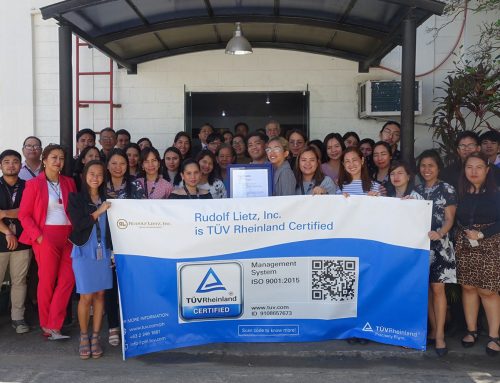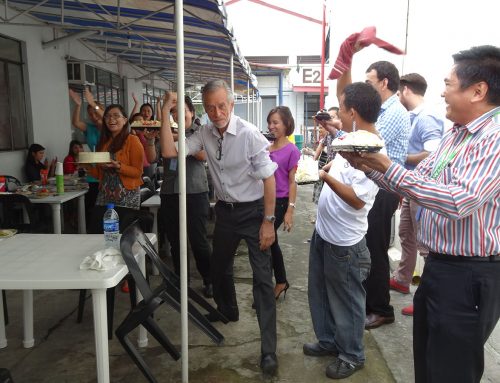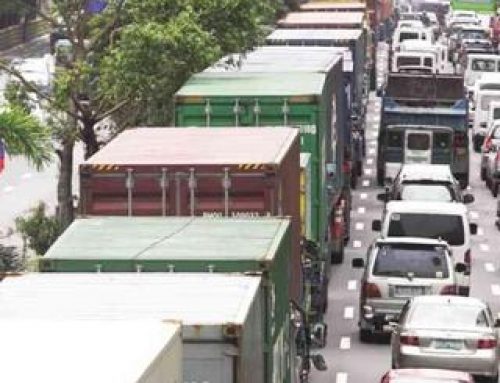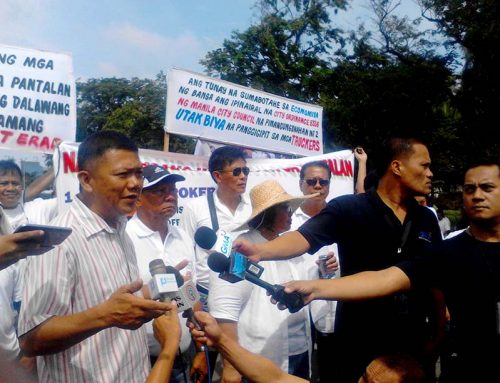SOURCE: http://www.mb.com.ph/christmas-import-arrivals-offset-port-decongestion-moves/
The government yesterday claimed that port congestion in Manila is already at its tail end but peaking volume of incoming cargoes due to the Christmas season have offset the various public- and private-initiated measures to normalize port productivity and cargo movements.
Transportation Secretary Joseph Emilio Abaya would not confirm or deny the persistence of port congestion in Manila but claimed that throughput has drastically increased from 3,900 outgoing laden containers per day during the Manila Truck ban to 7,000 units these days.
THE PORTS SUMMIT A PUBLIC-PRIVATE DIALOGUE – Guest of Honor and Speaker Secretary Joseph Emilio Aguinaldo Abaya (right) of the Department of Transportation and Communications with Col. Rodolfo de Ocampo (ret), president of Port Users Confederation, Inc. during the Port Summit Conference held at Centennial Hall of the Manila Hotel on Nov. 17, 2014. (Photo by Manny Llanes)
THE PORTS SUMMIT A PUBLIC-PRIVATE DIALOGUE – Guest of Honor and Speaker Secretary Joseph Emilio Aguinaldo Abaya (right) of the Department of Transportation and Communications with Col. Rodolfo de Ocampo (ret), president of Port Users Confederation, Inc. during the Port Summit Conference held at Centennial Hall of the Manila Hotel on Nov. 17, 2014. (Photo by Manny Llanes)
“I wouldn’t say there is still port congestion because it is expected that these are busy times considering that Christmas is coming soon,” Abaya told reporters at the sidelines of a port users’ summit held yesterday at the Manila Hotel.
“Manila is a busy port but the throughput indicates that goods are moving. It’s just Christmas season,” he added.
In his speech, Abaya stressed that port congestion won’t be solved with the lifting of the Manila Day-Time Truck Ban alone. He admitted that the ports of Manila are currently accommodating the backlogs representing shipments that piled up in Hong Kong, Singapore and Kaohsiung, totaling to at least 37,000 twenty-foot equivalent units (TEUs).
“Government cannot still say categorically that the port congestion has ended due to the sheer volume of backlog. But congestion is easing faster than anticipated and without any more disruption in the supply chain and barring any major calamities, we can see significant reduction in the number of cargo backlog both here and abroad prior to the end of the this year,” he said.
The Cabinet official admitted that shipping lines Hapag Lloyd, Hanjin Shipping and American President’s Line have temporarily pulled out their vessels from the Philippines for failure to ship out their empty containers and due to long queuing time for vessels calling into the ports of Manila.
“As much as we would like to decongest the Manila ports the soonest time possible, we are taking into consideration some issues like the scarcity of trucks, reduced yard productivity, limited yard capacity and the held-up cargoes abroad,” Abaya said.
“If we drastically send out majority of the containers inside the ports right now, foreign ports and shipping lines will send all the held-up cargoes to the Philippines all at the same time which we could not accommodate due to certain restrictions. What we are doing is we gradually move out containers to gradually take in those held-up cargoes. What we are working on right now is reduce the backlog here and abroad properly in order not to clog the ports once again with these held-up boxes,” he explained.
To recall, yard utilization level at the Manila South Harbor (MSH) and the Manila International Container Port (MICT) has peaked 104 percent between April and May due to the piled up containers at the port during the implementation of the Manila Day-time Truck Ban.
But Philippine Ports Authority (PPA) general manager Juan Sta. Ana reported that yard utilization level has reached between 85 to 87 percent in two ports. The ideal yard utilization level is pegged at 85 percent.
“We’re getting back to normal, it’s just a matter of time before we hit the target. The terminal operators are doing well despite the heavy influx of Christmas cargo. We’re tail end of decongestion except for the Christmas rush,” Sta. Ana said.
Apart from the various measures imposed by PPA to systematize cargo movements and maximize the yard utilization in MSH and MICT, Sta. Ana said they will further organize operation in the ports.
“Inside the port, we’ll implement a truck-by-appointment scheme, such that only those trucks with legitimate business will be allowed to enter the port. This means there will be no more hawkers that will keep roaming around the ports without an appointment. We are planning on implementing this around first quarter of next year,” Sta. Ana added.
Despite the progress in decongesting the ports of Manila, importers, truckers and other port users maintain that problem persists due to a several other factors.
“About this time last year, we used to make three to five trips per truck per week around Metro Manila. But now, we only make one to three trips per truck per week because of the slow turnaround time of our trucks due to limited container yard capacity,” said Rodolfo De Ocampo of the Port Users Confederation Inc.
“There is also congestion in the container yards. Trucks with empties remain parked in our garage until they can unload the empties at the container yards,” he explained. The slow turnaround time of trucks, De Ocampo said, has caused a 100 percent increase in their operational costs and forced them to double their trucking rates.
Meanwhile, Fernando Peña urged the government to considering exempting truckers from its franchising requirements.
“At least 90 percent of our trucks are already 15-year-old. If the age limit is strictly imposed among trucks, we will not be able to get the containers out of the ports and the country will loose its edge in the ASEAN Economic Integration. Our economy needs our trucks at this time,” he said.






Recent Comments